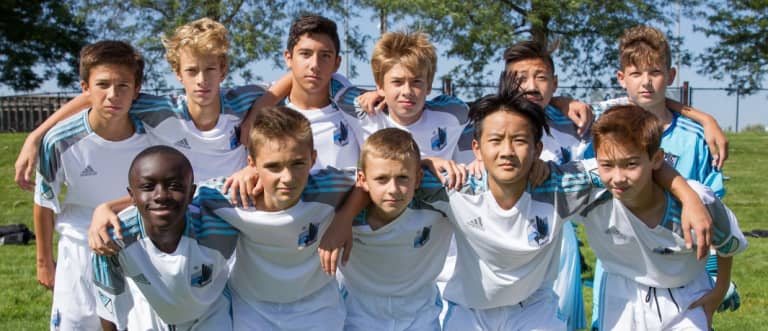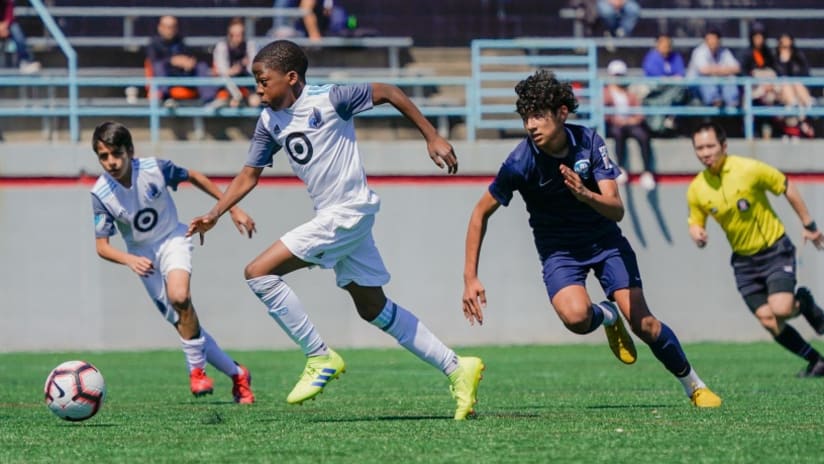Minnesota United announced a comprehensive restructuring of their academy and a new approach to youth development that marks a departure from the MLS norm with a focus on the particular environs of soccer in the North Star State.
Now in their fourth season in MLS, MNUFC have harvested just one Homegrown signing from their academy since 2017 and generally appeared a step behind comparable expansion peers of recent years. This year club leaders parted ways with most of their incumbent academy staff and paused to reevaluate, and the result is an overhaul crafted with their specific geography (isolated), climate (wintry) and culture (both tradition-rich and richly diverse) in mind.
“We have to do what's right for Minnesota; we have to do what's the correct things for our culture here, not only our culture in the community sense, but also in our football sense,” new academy chief Noel Quinn told MLSsoccer.com. “Because some of the things that work maybe in London or work in New York just simply would not work here or cannot work here, and we have to take best practices from around the world and then adapt them to our environment.”
Or as sporting director Manny Lagos puts it: “We're probably more like Iceland than a lot of the states within the US.”
The Iceland of MLS academies
The small, remote Nordic nation has become something of a Cinderella story in player-development circles as it learned how to punch well above its weight in UEFA competition, and parallels can be drawn to Minnesota.
With nearly 4 million residents, the Twin Cities have a decent sized, but isolated population to work with. By MNUFC’s calculations, their metro area is home to about 20,000 competitive boys youth players, while some 30,000 recreational players play seasonally statewide and upwards of 16,000 participate in ethnic and community leagues that fall outside traditional sanctioning structures.
The sport is beloved up there: Archetypal North American suburban youth soccer experiences combined with a history of welcoming refugees and other immigrant communities from across the world have cultivated a bouillabaisse of a local soccer hotbed.
But it’s a long way to the nearest metropolises to find competitive games: The likes of Milwaukee, Kansas City and Chicago are hundreds of miles to the south and east. And the recent past suggests that Minneapolis-St. Paul (MSP) may not be quite big enough to support multiple top-level academies in national leagues like the U.S. Soccer Development Academy or ECNL.
The long, cold winters – which also foster a huge ice hockey scene that competes for young athletes – drive everyone inside from November to March at the earliest, necessitating bubbles and other indoor venues with relatively cramped spaces.
The one-two punch of out-of-market travel and indoor facility costs poses a heavy burden for MNUFC and their local counterparts, gobbling up as much as 70 percent of a typical season’s budget. Quinn estimates that a basic 11-v-11 indoor winter scrimmage between two local MSP clubs costs around $700 just for the field space alone, while per-player costs for an academy program can balloon up to $10,000 per season.
All this threatens to impose a ceiling, in terms of both the competitive prospects of Minnesota teams in national competitions and the ability of players to maximize their potential. Meanwhile high-school soccer still occupies an important place in the soccer constellation and runs from August to November, a big chunk of the precious outdoor months.
“If you just think about that isolation for the competitive level and the balance of trying to get meaningful games outside the market vs. thinking about how to create meaningful games within the market, we just have to have a different mentality probably than almost every other market in MLS,” said Lagos.
“Ultimately, if we have to travel outside our market for all of our meaningful games, it's not a tenable business plan and it's not tenable for the amount of time to travel. So we have to address a little bit more internally how we're going to create meaningful moments for our local market.”

It should be noted here that the DA’s national 10-month schedule, which MLS’s new youth league is inheriting, for now at least, ran from August to June and forbid participation in scholastic soccer and other “outside” activities.
“We have a unique calendar here in Minnesota soccer,” said Quinn, an Irishman who has coached and directed at the youth, high-school and collegiate levels across the state for many years. “We pretty much follow a European calendar that doesn't actually work for us.
“We need to do what's right for right here.”
Reimagining youth development in Minnesota
So the Loons are trying something new.
Whenever MLS’s elite youth platform eventually launches in earnest – a process that has been disrupted by the COVID-19 pandemic – MNUFC will field what they call “representative teams” in the prime Under-15 and Under-17 age groups, and an Under-23 or reserve team of some sort to bridge the gap to the MLS first team.
Rather than full-time members of United’s academy, the players will be called up from their youth clubs to take part in “training pods” and national competition in MNUFC colors, then return for local action. They will spend training time in each environment, and literally wear the crest of their home club on their sleeves when donning a Loons kit. Each age group will have a pool of 35 to 40 players – roughly twice as big as before – to allow a wider net to be cast and have form and availability guide roster selections.
It’s somewhat comparable to a national-team callup or an Olympic Development Program invite, but far more immersive, running year-round, and just one part of a more comprehensive bond between United and the many small youth clubs dotting their region.

All parties will work together to craft personalized development plans for each player, with room for high-school ball and/or other activities that serve their overall progression. Minnesota United’s academy coaches will partner on this with their counterparts at local clubs, and also assist with methodology, coaching education, facilities costs and other priorities with an overall focus of elevating the level of competition and quality of prospects across the state.
In a shift from their previous setup, the Loons’ top-tier youth players will pay no fees, and the club has resolved to build deeper and more inclusive relationships with the ethnic communities where access to youth soccer is limited by the pay-to-play model. The idea, in keeping with the “United” moniker, is “to cultivate a soccer culture of collaboration, communication, transparency and connection,” in Quinn’s words.
“It's incredibly important that we individualize all of that training within our calendar, and it becomes much more intentional for each individual player in our market, and in our academy and in our program,” said Lagos. “So that allows us to really think about that development pathway for them. And if we only have one option for them, which is the MLS league, but they're not quite good enough, that's not good enough for us – we’ve got to continue to develop that kid.”
Can this hybrid approach make the most of Minnesota’s unique landscape? Will the rest of the MSP youth soccer community rally under MNUFC’s banner in pursuit of the greater good? Could it help the Loons make up ground in the academy arms race unfolding across MLS? While it will take time to answer those questions, United’s new tack deserves watching in the months and years ahead.













